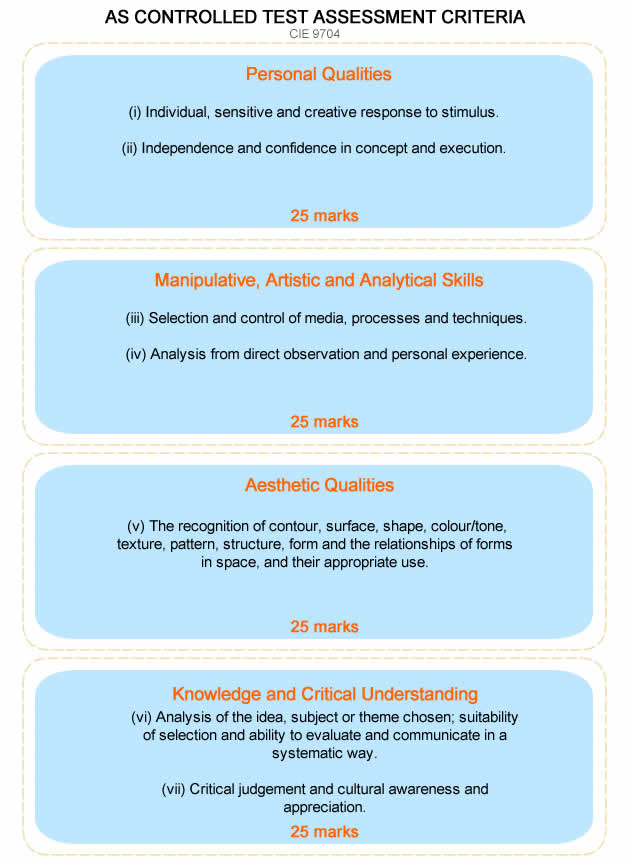Last Updated on April 2, 2023
This article gives tips, advice and guidance for students sitting their CIE AS Art Exam, written by an experienced teacher and Coursework assessor.
AS Art and Design students are required to submit:
- 1 x project (a two or three-dimensional final work, maximum weight 4.5kgs and maximum dimension in any direction of 750mm, completed within the 15 hour Art Exam)
- A maximum of 2 x A1 sheets (4 sides) of preparatory work. This is a body of work illustrating a visual response to one examination question, using any appropriate colours, tones, mediums, processes or techniques. The preparatory work is to becompleted before the examination and must include direct observation from primary sources, research, analysis and 2D and/or 3D development of ideas. The preparatory work must be:
- Mounted on a maximum of 2 sheets of A1 paper that are fastened together at the top left hand corner by a piece of string (or something similar);
- Clearly labelled and distinguishable from the examination piece (this is especially important in Graphic Design and Photography where the boundary between prep work and examination work is sometimes not clear);
- Brought in its entirety into the examination room at the start of the exam. After the first examination session, the work can no longer leave the examination room and it is unable to be accessed between examination sessions.

Preparing for the AS Art exam
The AS exam paper should be given to students as soon as the school receives it (at the discretion of the Art teacher/s), a minimum of three weeks before the Controlled Test itself. If students are enrolled correctly (and well in advance), the examination paper should arrive several months before the examination, which gives students ample time to prepare. It can sometimes be advantageous to withhold the examination paper a few days until their AS Art Coursework is completed, as this ensures that students have their focus on one component at a time. It is essential that the Coursework deadline is relatively early, however, to give students maximum time to prepare for the exam.
The exam paper is a list of topics, from which you must select one. Some topics are very broad and have a lot of room for personal interpretation (i.e. “on the edge”) while others are narrow and suitable for those who like more direction (i.e. “an arrangement of several different items of footwear”). Some are tailored specifically for Design students (i.e.”design a poster for a Festival of Dance to be held in your district or region. Include essential information, such as the location, dates, times and venue”) whereas others are general topics. You should discuss your topic selection with your teacher and seek guidance regarding interpretation and choice of source material. You are able to interpret questions in any way you wish.
The examination artwork does not have to relate to your AS Coursework in any way, but there are obvious advantages to having some overlaps. It is worth remembering that although the examination is worth more marks than the Coursework, there is far less time to complete it. One helpful strategy can be for students to follow a similar development process to that used in their Coursework (i.e. using the same artist models and a similar pattern of developing composition), as this allows students to work much faster. It means students have to ‘think’ and worry less, and simply put all of their effort into producing stunning artwork within the short time frame given. As the subject or theme is of course totally different (because it is selected from the examination paper), students are thus excited and invigorated about their work, despite the processes being very similar to their Coursework, at least in the initial stages. As the work progresses, the new topic usually drives the work in a new and exciting direction, so the final pieces are quite different.
One important difference between the examination and Coursework is that is that observation from primary sources is essential within the examination submission. This means that, at some point, (usually in the very early stages of investigation – if not for the whole duration), students must work whilst looking directly at a scene or object. In other words, they must have the subject matter directly in front of them, and must not draw from photographs taken by others. The purpose of this requirement is two-fold: firstly it ensures a direct interaction between viewer and subject (hopefully resulting in work that is more personal, detailed and ‘authentic’); secondly it avoids students attempting to create a submission based entirely from plagiarised second hand images (those taken from the internet etc).

Before the AS Art exam: a checklist
- Finish your preparation work. Do not expect to be able to complete any of the prep work during the examination itself. If you finish your final examination project early (except perhaps in the case of extremely abstract works), you should ask yourself whether your artwork is too simple or poorly executed. At AS Level, students are required to have an extremely competent final piece. The Art examination is fifteen hours long for good reason. Many students find the fifteen hours not enough. It is in your absolute best interests to have all preparation work completed in advance of the first examination session, so that you can use every second of the fifteen hours to produce the most amazing final piece you can.
- Plan what your final examination artwork will look like, and how long each stage will take you. Obviously you cannot plan it exactly – and certainly do not attempt to complete a whole ‘practice’ version in advance (I have seen some students attempt to do this and their ‘real’ works rarely turn out as well as the practice one). But plan it enough so that you don’t waste any examination time thinking about what to do. Your preparation work should allow you to practise all the different components of the final work (perhaps not in exactly the same way, but enough that you are confident you can execute every aspect of it). Trial setting up the still life and/or pre-print high-quality photographs to work from.
- Prepare a ground if needed. If you specialise in Painting and Related Media) you are permitted to prepare the ground (the undercoat) in advance, which may also include patterned or textured paper. An undercoat must obviously not include any outlines or preliminary drawing. Other areas, such as Graphic Design, Textiles making, Sculpture and Ceramics, candidates can, in addition to their supporting work, prepare specific material for the examination beforehand. If you are unsure what is permissible, contact CIE directly for clarification.
- Ensure all equipment you need to use is ready and working – pencils sharpened / paint tubes full etc.
- Bring your supporting work to the exam! If you forget to bring it to your first examination session, you will not be allowed to submit it later. You will just have to hand in your final piece;
- Immediately before the exam is to start, set up your work station. Prior to the examination, you should be let into the room to set up your equipment, materials and a still life (if needed). You should set up everything you need and should not have to share basic equipment with anyone else. Put your supporting sheets of work neatly beside you to refer to. Note: You are not allowed access to any books, magazines or artwork of other artists. Artwork may be on the walls, but you must not access this, copy it or try to submit it as your own. You are also not allowed to use any hazardous items in your work, such as needles, syringes, broken glass, razor blades, barbed wire, or those that contravene bio-security immigration rules, such as unfired clay, animal skin or fresh organic matter (i.e. leaves).

During the AS Art Exam: instructions for students
- You may move around the room as needed, to empty your water jar / get additional materials etc, although this should be minimised to reduce disturbance of others.
- Tracing is rarely allowed and only in specific situations, for example, when incorporating a motif that had been designed earlier as part of a Graphic Design submission. It is not acceptable for a Painting and Related Media student to bring an enlarged photograph to the exam and trace it. In the rare circumstances where tracing or copying is permissible, it is to be done from the supporting work and must take place within the examination.
- Technical assistance is allowed if you need it, such as assistance firing ceramics, welding metal sculptures or pouring out photographic chemicals, however at no stage can you ask your Art teacher (or exam supervisor) for any advice about your art or design work. All decision-making that occurs within the examination session must be your own. Any conversation between you and the invigilator must be minimal and be restricted to that which is essential. Students must not communicate with each other. It is often preferable that it is not your Art teacher supervising, to prevent subconscious grimaces by the teacher when a poor colour choice is made, for example! It can also put the students at ease to have a ‘non artist’ in the room – so they don’t feel pressure from an art specialist watching and ‘judging’ their efforts as they work.
- CIE recommends that the 15 hour examination be broken into shorter sessions lasting no more than 3 hours at a time, with the whole exam ideally completed over three consecutive days.
- Once the exam is over, work can be dried, sprayed with fixative, trimmed, mounted, ceramics fired, labelled etc, prior to posting away. This should not happen within the exam session itself.
Assessment of the AS Art Exam (Controlled Test)
The CIE Controlled Test is worth 60% of your final AS grade and 30% of your final A Level Art grade. It is externally assessed (i.e. marked entirely by CIE examiners). Most countries send examination work to Cambridge University to be marked; other counties, like New Zealand, have the examiners travel to them.
The final exam work and supporting pages are assessed together and are given a single mark out of 100. The following assessment criteria are given as a guide:

AS Art Exam examples

Further examples of AS Art exam work will be added here over the coming months.
To inspire you, here is a beautiful youtube video of students working on their A Level Art exam final pieces:
This article relates to the AS Controlled Test (also known as the AS Art Exam), Component 1, CIE 9704 A Level Art and Design – the International version of A Levels, run by the University of Cambridge. Information is sourced from the CIE A Level Art and Design syllabus.
If you would like to see more great examples of student work, please view our Featured Art Projects.


